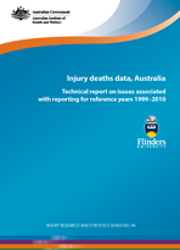Summary
This technical report is a companion to the statistical report Trends in injury deaths, Australia 1999-00 to 2009-10. The technical report provides additional information on data sources and methods.
The primary source for the surveillance of injury mortality in Australia is the series of cause of death unit record files (CODURFs), produced by the Australian Bureau of Statistics (ABS) on the basis of data from registries of births, deaths and marriages and from the coronial system. Supplementary sources also exist for injury deaths due to some external causes. These sources were used to assess the completeness and consistency over time of estimates based on the CODURFs, particularly during a period in which methods for producing and releasing the CODURFs changed considerably. This is relevant to injury surveillance because the changes mainly affected deaths certified by coroners. These deaths include nearly all injury deaths, except most of those due to falls by older people. The changes included increasing reliance, from 2003 to 2006, on the National Coronial Information System (NCIS) as the source for information on causes of injury deaths, followed by changes to methods for processing and releasing the CODURFs when problems became apparent. The most notable change was the adoption of a program of multiple releases (normally three) for data in each reference year.
The enumeration of injury deaths in the CODURF overall in reference years 1999 to 2010 appears to have been fairly constant, except for two upward steps. The first of these was about 1% in 2006 (revised) data, when ABS methods changed in a way that reduced the number of deaths that remained with unspecified cause (ICD-10 code R99). The second-of about 8% in the reference year 2008-coincided with the introduction by the ABS of changes in methods that increased scrutiny of attachments to records in the NCIS and of Part II of death certificates if a specific cause was not provided by Part I.
With some exceptions, CODURF-based estimates of injury deaths due to particular major external causes were consistent with estimates based on supplementary sources for several reference years before 2003 and from 2006 (revised release) onwards; however, they differ to a noteworthy extent for several external causes from 2003 to 2006 (first release).
CODURF-based estimates were low in the intervening period for transport injury, poisoning by non-pharmaceutical substances, intentional self-harm (suicide) and homicide. Conversely, they were high for cases assigned to categories in the unintentional causes block that involved mechanisms commonly used in suicide and homicide (for example, shooting, hanging and strangulation) and injury cases for which an external cause was not specified.
Deaths due to fall-related injury are a special case, being the only type of injury death in which most cases are certified by a medical practitioner. Very large rises occurred in the numbers of deaths assigned underlying cause codes for unintentional falls yet the numbers of such deaths underestimate fall-injury mortality. Neither trends nor rates of cases assigned underlying cause codes in this range are a reliable guide to mortality from this cause. Evidence from Victoria (where administrative changes in 2003 caused nearly all cases of this type to be registered by coroners), as well as research based on linked data, and supplementary estimates based on deaths of hospitalised fall injury cases (which include most of the deaths) all favour estimates that are obtained from CODURF data using multiple cause codes as well as underlying cause codes to identify fall injury deaths.



